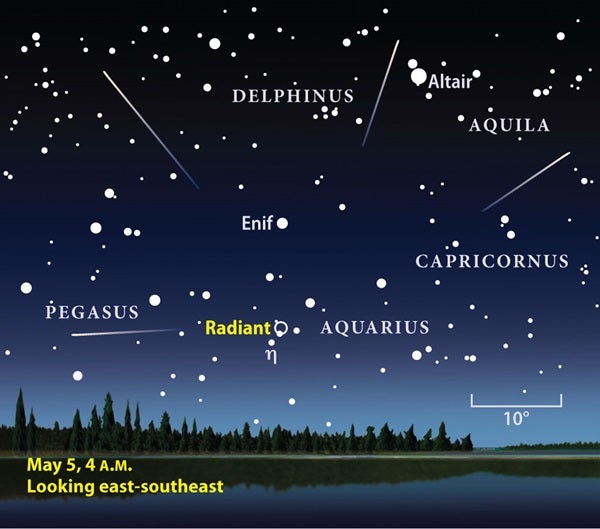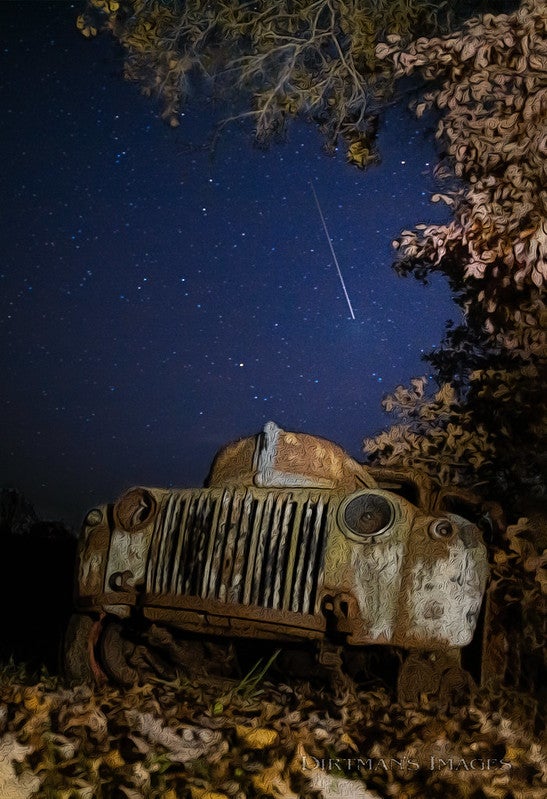The Eta Aquarid meteor shower is usually one of the year’s best, and it peaks again in early May. This year, however, the Full Moon occurs May 5, which is the date of the shower’s maximum. Our natural satellite’s light will scatter across the sky all night, but observers who plan carefully still may see enough meteors to make the venture worthwhile.
In 2012, the shower is active from April 19 to May 28. Unfortunately, you’ll only spot a few meteors each night except for the prime period within a few days of the May 5 peak. Usually, the days before and after maximum offer observers with access to a dark observing site up to 30 meteors per hour. This number jumps to 60 per hour at the shower’s peak the morning of May 5.
The best conditions occur in the tropics and the Southern Hemisphere because that’s where the radiant climbs highest. The radiant is the point on the sky where all of a shower’s meteors seem to come from. This spot lies slightly north of the 4th-magnitude star Eta (η) Aquarii. Its close proximity to that star is how this shower got its name.
From midnorthern latitudes, the radiant rises during early morning hours but never climbs all that high. At the shower’s peak, observers usually expect to see long meteor trails, some of them accompanied by persistent smoke trails. This year, however, the bright Moon may dampen such expectations.
Comfort counts when observing meteor showers. Most importantly, you must keep warm. Observing is not a physical activity — you’ll just be standing or sitting. When you’re ready, set up a lawn chair, preferably one that reclines. Your best strategy may be to start observing around 3 a.m. local daylight time the morning of May 5. Face east, and focus on a spot about halfway up from the horizon. Glancing around won’t hurt anything. Because the Full Moon will be in the west, position yourself where a building, trees, or a vehicle blocks its unwanted direct light.
Astronomy magazine Associate Editor Bill Andrews encourages everyone to view meteor showers. “They’re a great family activity,” he says. “Just set up a few chairs, and ‘ooh’ and ‘aah’ all night. Plus, you don’t need any special equipment — your eyes work best for viewing this event.”
Eta Aquarid meteors start as small dust particles cast off by Halley’s Comet during its innumerable trips around the Sun. Every May, Earth encounters the comet’s debris stream. The particles travel fast relative to our planet — nearly 150,000 mph (240,000 km/h). As they enter our atmosphere, they burn up and create incandescent columns of air we view as the meteors.
Meteor shower facts
- Meteors are small particles of rock and metal that Earth encounters during its orbit around the Sun. In space, astronomers call these particles “meteoroids.” If they burn up in Earth’s atmosphere, they become “meteors.” Finally, if the particles survive the fiery ordeal of passage through our thick blanket of air and land on Earth, we call them “meteorites.”
- All meteor showers except January’s Quadrantids and December’s Geminids originate from comets. When a comet swings around the Sun, it leaves a trail of debris (small meteoroids). Sometimes, the orbit of this debris crosses Earth’s orbit. When Earth runs into this stream of particles, we experience a meteor shower.
- No known meteorite has come from a meteor shower — the particles are too small.
Interesting facts about meteors
- To be visible, a meteor must be within about 120 miles (200 kilometers) of an observer.
- Meteors become visible at an average height of 55 miles (90km). Nearly all burn up before they reach an altitude of 50 miles (80km).
- The typical bright meteor is produced by a particle with a mass less than 1 gram and a size no larger than a pea.
- The hourly rate on a “non-shower” night is approximately 6 meteors per hour.
- A meteoroid enters the atmosphere at velocities between 50,000 and 165,000 mph (81,000 and 265,000 km/h).
- Video: Easy-to-find objects in the 2012 spring sky, with Richard Talcott, senior editor
- Video: How to observe meteor showers, with Michael E. Bakich, senior editor
- StarDome: Locate the shower’s radiant in Aquarius in your night sky with our interactive star chart.
- The Sky this Week: Get your Eta Aquarid meteor shower info from a daily digest of celestial events coming soon to a sky near you.
- Sign up for our free weekly e-mail newsletter.











